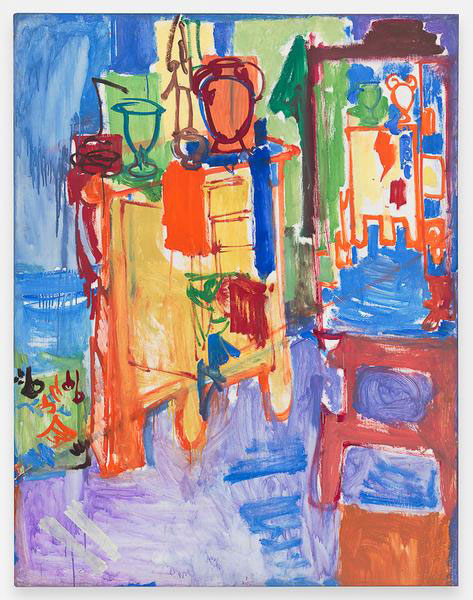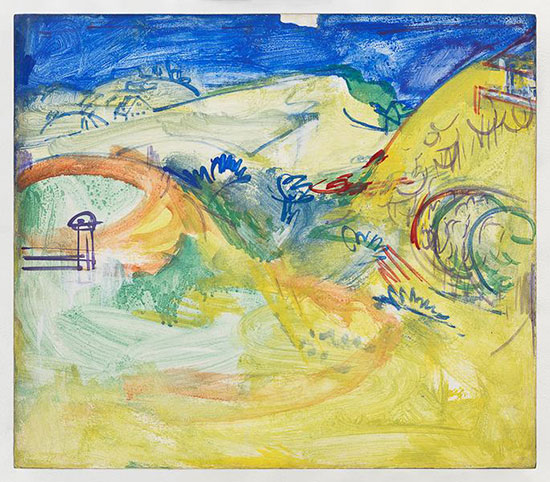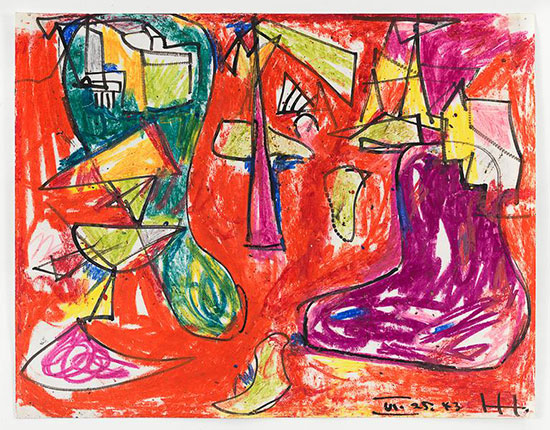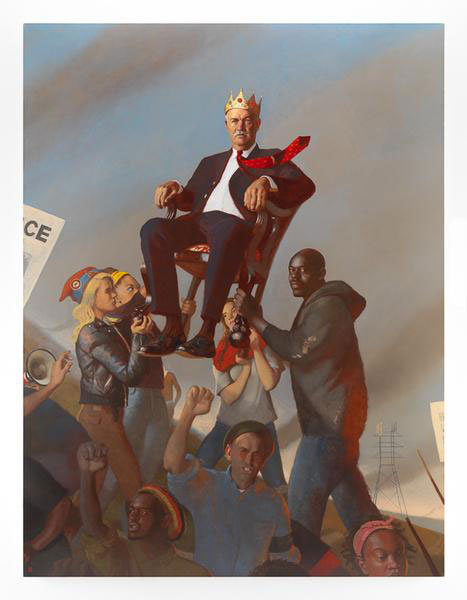Visitors to the Ameringer McEnery Yohe gallery in Chelsea this summer will find two very different painting exhibitions on view through August 12, 2016: “Hans Hofmann: The Summer Studio” and “Bo Bartlett.” Painter Hans Hofmann is the patron saint of teachers in summer who finally find the time to work on the novel, sonata or landscape that has been too long deferred in favor of marking student portfolios and compositions.
It is Hofmann's own summer studio on Cape Cod that lends its title to the small but joyously rewarding solo exhibition at Ameringer McEnery Yohe. Appropriately enough, the show’s centerpiece is Studio Unfinished, painted in 1936 when Hofmann’s life was dedicated to grooming a new generation of Abstract Expressionists (the term was actually coined in a review of his work).
.

"Studio Unfinished" by Hans Hofmann, 1936. Oil on panel, 54 x 42 inches. Courtesy Ameringer McEnery Yohe gallery.
.
With pale washes of mauve and streaks of sunlit blue, it is more like the dream of a studio than a substantial interior, and the incorporeal outlines of the furniture call to mind a masterpiece by Henri Matisse at MoMA, The Red Studio, painted in 1911 when he and Hofmann were friends in Paris, fellow students at the Academie de la Grande Chaumiere.
Hofmann used anecdotes about his color conversations with Matisse to illustrate his lectures, and there is a visual conversation between Studio Unfinished and The Red Studio. For one example, the framing device of the mirror and the looping stroke with which Hofmann conjures the ideal of the vase are both echoes of the Matisse.
For more than four decades, beginning in 1915 in Munich, Hofmann’s art took a back seat to his role as the selfless, generous guide to a brazen new approach to painting. The critic Clement Greenberg called him the greatest art teacher of the 20th century. His student rosters included the names Louise Nevelson, Alfred Jensen, Fritz Bultman, Lee Krasner, Nell Blaine, Wolf Kahn, Richard Stankiewicz, Mercedes Matter, Red Grooms, Joan Mitchell, Helen Frankenthaler, Allan Kaprow, Giorgio Cavallon, Jan Muller, Jane Freilicher, Larry Rivers and Vincent Pepi, whose work on view at the Quogue Gallery was reviewed in July 2016 on HamptonsArtHub.com.
Hofmann taught at the University of California, Berkeley, the Chouinard School of Art in Los Angeles, the Art Students League (beginning in 1932) and in 1934 created his own schools, one on Eighth Street in Manhattan and another at a summer outpost in Provincetown, on Cape Cod. A major exhibition launched at MoMA in 1963 had just completed its tour around the country when the artist died in New York at age 85.
A hallmark of Hofmann’s instruction was his substantial contribution to modern color theory, based on his experience with the School of Paris and the Fauves as well as his work in the design studio of Robert and Sonia Delaunay.
The exhibition at Ameringer Mcenery Yohe may be limited to a few works, but it abounds in chromaticism. The dialectic of blue and gold carries the color argument of In the Hollow, a visit to the dunes of Provincetown under a sky as intense as any Mediterranean scene from the works of Matisse. As he did so successfully in Unfinished Studio, Hofmann swiftly suggests architectural forms by mere outlines, while flicks of the brush transcribe the action of the wind, a favorite motif in his repertoire.
.

"In the Hollow" by Hans Hofmann, 1936. Casein on panel, 19 3/4 x 22 3/4 inches. Courtesy Ameringer McEnery Yohe gallery.
.
The light-toned medium of the work is casein on panel—a water-soluble paint used frequently by Hofmann that is perfect for washes and dries to a matte finish. This was the go-to medium for quick landscape studies of this kind until the advent of acrylics in the 1960s.
A heavier color statement is made by Red, Purple and Green, a crayon and ink drawing on paper which pumps the red to a vibrancy that fills the space. The black ink lines swing in the confident arcs and sharp-edged angles that characterize not only Hofmann’s life studies but those of many of his students. This reviewer sees these arcs and angles in the nudes of Fritz Bultman, for instance. These flourishes may also look back to the open black lines seen in some of Picasso’s Cubist drawings, another point of contact from the artist’s years in Paris.
.

"Red, Purple and Green" by Hans Hofmann, 1943. Crayon and ink on paper, 11 x 14 inches. Courtesy Ameringer McEnery Yohe gallery.
.
The absolute highlight of the show for me is a large vertical oil on canvas, Summer Glory, painted in 1944. The painting glows with Hofmann’s red, dashes of the green that were his joy during June on the Cape, and a bloom of white across which his impasto builds tiny sculptural details. At the bottom edge, a bird that seems to have migrated from a Paul Klee painting offers a great excuse for the display of more color.
.

"Summer Glory" by Hans Hofmann, 1944. Oil on panel, 55 x 40 1/2 inches. Courtesy Ameringer McEnery Yohe gallery.
.
This was the pastoral mode that Hofmann enthusiastically urged upon his students while they were in Provincetown, the healthiest source they could find. Famously, when Lee Krasner introduced Hofmann to Pollock, the teacher’s voice of experience suggested that Pollock was missing out on the chance to work from nature, to which Pollock is said to have replied, “I am nature.”
Pollock’s conception of nature aside, Summer Glory masterfully demonstrates that an artist attuned to the stimuli of the garden, for one example, gains a running start on what may evolve into an abstraction. Hofmann fearlessly sped toward form in the direction of color.
A passage from his lectures, in addition to demonstrating his magisterial eloquence, reveals the secret of how Summer Glory commands the viewer’s senses: “Color has the faculty to create volume and luminosity. Volume is a dimension—a dimension in and out of depth. Every difference in color shade produces a difference of speed in depth penetration. In hand with it goes its luminosity … the way that colors are related can create drama, poetry, lust, pain, pleasure, ache and so on.” A corner of the garden in Provincetown explodes into the agon of red and green. It is no wonder his students were entranced.
Before reaching the Hofmann paintings, visitors traverse two rooms at the gallery dedicated to an exhibition of the large-scale, crisply painted and often disturbing works of Bo Bartlett, a contemporary realism painter who brings a satirical edge to the Norman Rockwell narrative mode.
I wish I could report that I was as impressed by the ostentatious talents reflected in Bartlett’s work. I liked the way the gallery presented the top hat, violin and other accouterments of these meticulously rendered paintings in vitrines by the paintings, and it was a great idea to have the studies for the works in a separate room where they showed the skill and training the artist acquired at the Pennsylvania Academy of the Fine Arts.
The first and most prominent painting in the show, called The American, is a mock heroic image of a man in jacket and tie taking aim with a long rifle. In an accident of timing, the day the show opened a sniper used a rifle to ambush a peaceful demonstration in Dallas, making the choice of the leading work, for this reviewer anyway, both unlucky and chilling.
.

"The American" by Bo Bartlett, 2016. Oil on linen, 82 x 100 inches. Courtesy Ameringer McEnery Yohe gallery.
.
Bartlett lives in Georgia and in Maine, where this image, at a different time, might be perceived differently, I suppose. His work is enigmatic in a Balthusian way, including his depiction of views up the skirts of adolescent girls. It can also be bluntly rhetorical, as with the crowned and insipidly smiling one-percenter in Oligarchy, who is borne aloft in a chair by an African-American and some attractive hipsters evoking a contemporary Brooklyn ethos.
.

"Oligarchy" by Bo Bartlett, 2015-2016. Oil on linen, 120 x 88 inches. Courtesy Ameringer McEnery Yohe gallery.
.
There are potent technical as well as political statements in Bartlett’s work that are bound to draw attention to the show, which could not be more remote in its cool from the warmth that envelops visitors to the Hofmann gallery.
_________________________________
BASIC FACTS: “Hans Hofmann: The Summer Studio” and “Bo Bartlett” are on view July 7 to August 12, 2016 at Ameringer McEnery Yohe Gallery, 525 West 22nd Street, New York, NY 10011. www.amy-nyc.com
_________________________________
Copyright 2016 Hamptons Art Hub LLC. All rights reserved.
